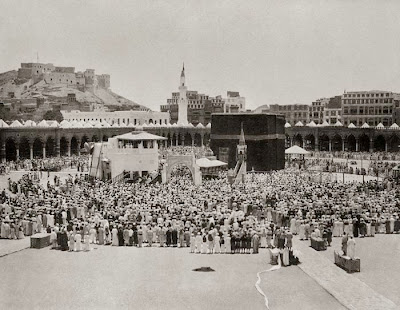 Christiaan Snouck Hurgronje: The First Western Photographer in Mecca, 1884-1885
Christiaan Snouck Hurgronje: The First Western Photographer in Mecca, 1884-1885
Auteur Durkje van der Wal; Manfred & Hanna Heiting Fund / Rijksmuseum; 40 kleurenafbeeldingen, 56 pagina's, gebonden
He was an adventurer, a scholar, and possibly a spy -- but as Dutchman Christiaan Snouck Hurgronje proved with his rare 1885 photographs and sound recordings of Mecca, he was also a pioneering multimedia journalist.
Snouck's extraordinary collection of sepia-tinted images of Mecca in a bygone age have gone on display in Dubai ahead of the annual Hajj pilgrimage that originally drew him to the heart of Islam.
Accompanied by crackling, eerie soundscapes captured by Snouck using Thomas Edison's newly-invented wax cylinders, the exhibition paints a very different picture from the ornate and built-up Mecca familiar to modern visitors.
Among the newly-restored platinum prints, one image taken from a nearby hillside shows the Kaaba, the instantly recog nizable cubic building considered by Muslims to be the holiest place on the planet.
But though the galleried compound which surrounds it is echoed by Mecca's contemporary architecture, the sparsely-built city of Snouck's era bears only a passing resemblance, as do the rudimentary travelers' tents on the dusty plains outside the city.
The images are all the more astounding, says Elie Domit -- creative director of Dubai's Empty Quarter gallery, which is hosting the exhibition -- when one considers the lengths he went to to get them.
"People tend to forget the situation because cameras today are so versatile and light," he told CNN. "In Snouck's day they probably weighed about 40 kilos, and he needed to take all the chemicals for developing, which he would have done on site."
"And he not only took photographs, but also recorded sounds. Can you just imagine going there and going through all the hardship to record that moment in history? It's fascinating."
Also fascinating, says Domit, is the story of Snouck himself. A pioneering traveler, he was a rare Western presence in Mecca, but embraced the culture and religion of his hosts with passion, converting to Islam.
He stayed for five months, documenting the run-up to Hajj, but although he had intended to stay for the pilgrimage, he was forced to leave after unfounded accusations of his involvement in an attempt to steal a historical artifact.
"Being one of the first Europeans, people were suspicious of his agenda, particularly as he had gained the confidence of the Ottoman leader," added Domit.
"So when they heard the rumor he was a thief, he had to escape -- leaving his camera equipment behind."
The equipment wasn't wasted. After Snouck's departure, Al-Sayyid Abd al-Ghaffar, a local physician that the Dutchman had worked alongside, began using the camera, possibly becoming Mecca's first home-grown photographer.
Al-Ghaffar continued sending his images to Snouck in The Netherlands. Many of the photographs were originally credited solely to Snouck but they are now jointly credited, with experts unable to tell who shot what.
The images, archived by Leiden University Library, were published four years after Snouck's trip. Original copies of the album now sell for about $45,000, according to the gallery.
There was, says Domit, more to Snouck than pictures and sound.
"He never said himself that he was a spy because there was no Hollywood to pay tons of money for his inside story, but there have been many documents and historians claiming this.
"Most likely he was working as an agent of espionage in order to furnish information to the Dutch who had an interest in finding out about Muslim insurgents trying to topple the colonialism of the Netherlands.
"But he was also very convinced about the state of Islam, very knowledgeable and very dedicated. He was a kind of dichotomy: Here was a guy sent on a mission, but after he arrived he was convinced by and converted to Islam.
"I'm sure in terms of his personality, it was quite difficult."
According to Domit, Snouck also left behind a pregnant Ethiopian wife when he fled Mecca, but later married again while working in the what is now Indonesia. "He married several times, I believe. Very convenient when the Dutch government is paying your bill." See also The Snouck files ...
Uitgeleide van hajs (hadjis) bij Koetapandjang, Gajolanden (?)
Indisch filmarchief: Het groote Mekka-feest Unieke beelden van pelgrimstocht in 1928
In 1928 maakte het Krugers Filmbedrijf een 4-delige film over de pelgrimstocht van Indonesische islamieten naar Mekka. Destijds zeer bijzondere beelden, de film begint dan ook met een foto van de cineast Krugers: "De koene operateur, C. Krugers, die er voor 't eerst in slaagde een filmbeeld naar waarheid vast te leggen van dezen over de geheele wereld zoo bekenden doch noch nimmer door een Westerling gezienen pelgrimstocht." De film bevat unieke beelden van Arabische steden in de jaren 20.
Pilgrims from Aceh in the Dutch Consulate in Jeddah for the hajj to Mecca
Mekkagangers uit Ambon Key en Banda (Molukken) in het Nederlandse Consulaat in Jeddah Saoedi Arabië
Mekkagangers uit Mandeling Sumatra in het Nederlandse Consulaat in Jeddah Saoedi Arabië
Mekkagangers uit Palembang in het Nederlands Consulaat in Jeddah Saoedi Arabië
Terugkomst van de Mekkagangers op het eiland Bawean Surabaya Java






























Geen opmerkingen:
Een reactie posten